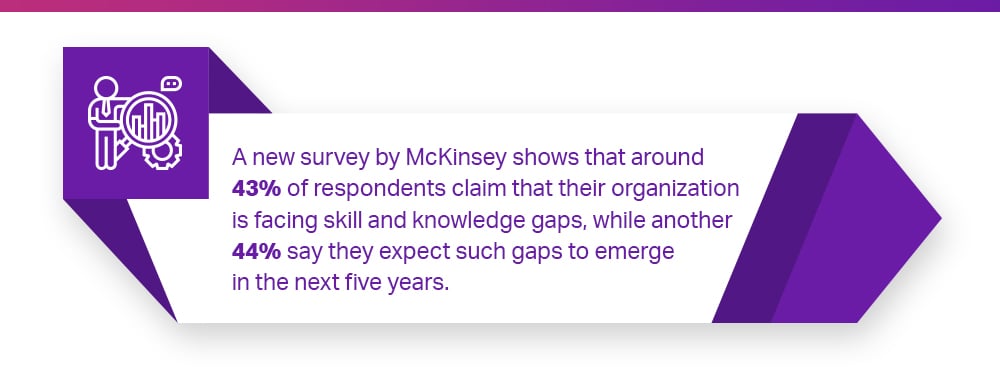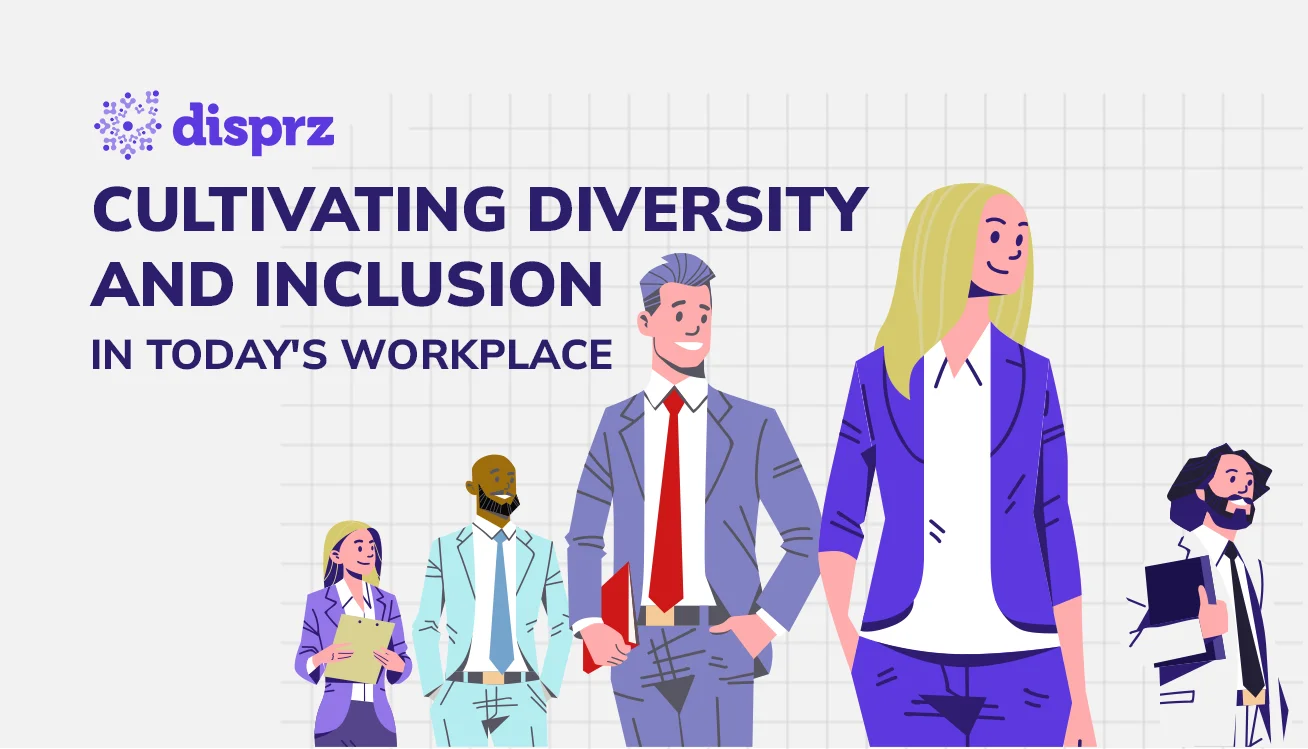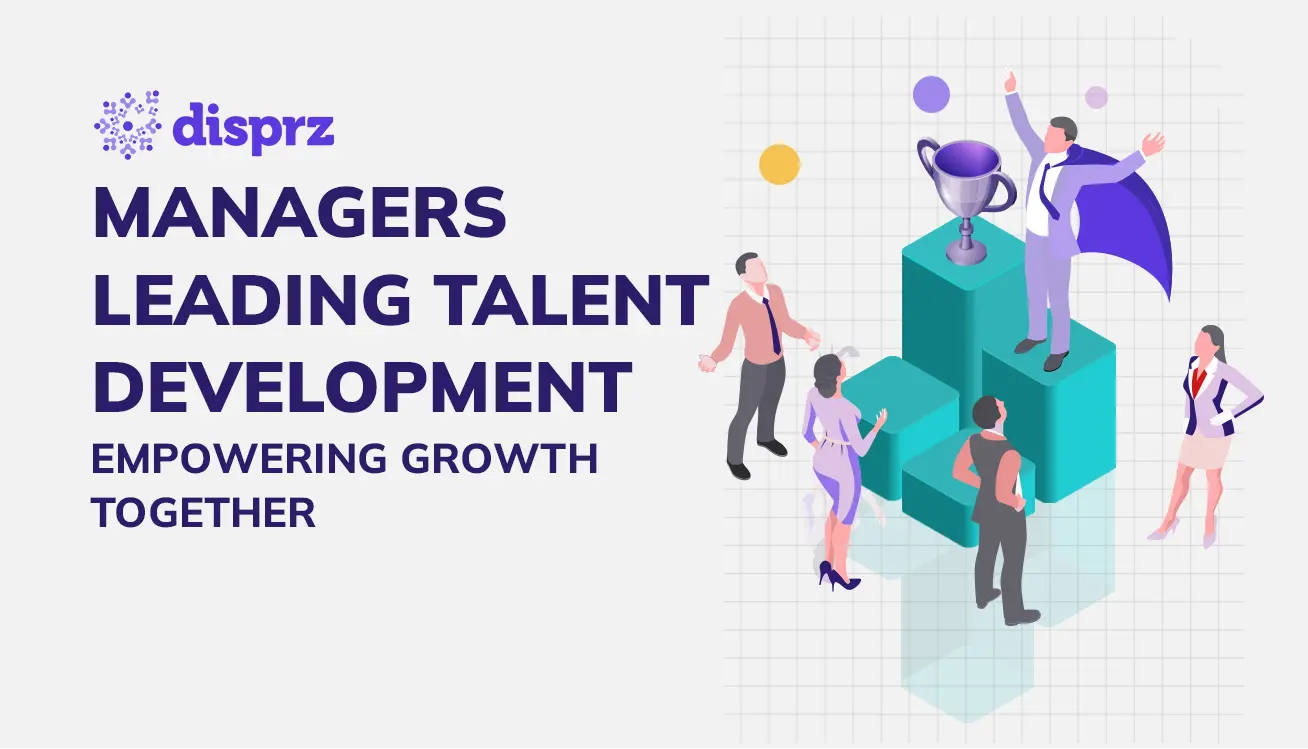
6 min read
• 18 Apr 2024
Identify and Address Knowledge Gaps in your Organization
Knowledge gaps and skill gaps can affect the bottom line of your business. Discover how to identify and address these gaps before they become costly.
- What are Knowledge Gaps in the Workplace?
- 4 Reasons for Knowledge Gaps
- Facing Challenges When Closing the Knowledge Gap
- 3 Ways to Identify Knowledge Gaps in Your Workforce
- 5 Steps to Conduct a Knowledge Gap Analysis
- Conclusion
-
eBookEmployee Upskilling - A Detailed Blueprint For Building A Skills-Driven Learning Culture
Table of contents
As businesses rapidly embrace new models and strategies to include updated technology and changing customer needs, many organizations are witnessing knowledge gaps. These gaps are expanding, as many employees are now required to do jobs that they weren’t hired or trained to do.

The above data shows the importance of bridging knowledge gaps and highlights that few organizations are prepared to do so. Addressing these gaps is crucial as they can be the biggest liability for your business. This article will detail how your company can identify these gaps and bridge them before they cost your business.
What are Knowledge Gaps in the Workplace?
Knowledge gaps refer to the difference between what an employee currently knows and what they need to know to perform their role effectively. Such gaps either result from hiring employees that are inexperienced or are not suitable for the job.
Companies are often forced to hire employees who do not have the required qualifications due to a staff shortage. These gaps are further exacerbated due to employee ambivalence and lack of proper training. These deficits often arise due to the changing nature of the market, which requires a business to revamp itself and upskill and reskill employees constantly.
It is crucial for a business to quickly identify and bridge these knowledge gaps to boost its revenue and sales. A worker that doesn’t have the required knowledge can cost the business a potential client or customer. These employees bring down the productivity of the entire workplace, making it difficult to achieve targets and goals and drive business directly to your competitors. Not understanding how to do their job efficiently can also demotivate employees and force them to quit.
Each workplace is different, and to succeed; you have to determine the specific knowledge gaps and skill gaps in your workforce.
4 Reasons for Knowledge Gaps
A gap in knowledge is costly for employers when it comes to lost productivity, high turnover, morale, team innovation, profits, and so on. It is critical to conduct a quick analysis to identify the necessary knowledge gap and exactly what it would take to fill the gap with training programs.
1. Emerging technology
Technological innovation creates digital skill gaps at a rapid pace that is challenging to address. Due to automation and artificial intelligence, many jobs have become obsolete, but new ones have been created to support emerging technologies. Likewise, the gig economy changes hiring managers’ look for candidates and how workers provide particular knowledge and skills.
2. Inadequate learning
Learning that’s inadequate contributes to knowledge gaps. It must evolve at all levels to help close those gaps. Several employees lack competence as digital skills become more in demand across all industries. It’s crucial to incorporate more technology wherever possible in foundational skilling and accommodate all types of learner personas.
3. On-the-job training
Another reason for knowledge gaps is a lack of on-the-job training, as companies no longer hire and train based on potential. They’d rather shop for the cheese-ready sandwich than spend time making their own. Hiring managers seek “expert” candidates because of the emphasis on immediate performance. It’s an overlooked opportunity to invest in long-term employees and results.
4. Lack of soft skills
People’s soft skills make them delightful to work with other teammates. Soft skills make work life manageable and include abilities such as:
-
Innovation in problem-solving, conflict resolution, and innovation assists businesses in competing.
-
Persuasion is a necessary skill in both client negotiations and leadership.
-
Collaboration delivers better outcomes and is the skill that allows an organization to function.
-
Adaptability enables a company to stay on its feet and overcome complex challenges.
-
Effective communication includes emotional intelligence, a soft skill that improves work relationships.
Facing Challenges When Closing the Knowledge Gap
It’s evident that there is an imbalance between the number and skill level of people available to meet the demands of the modern labor market. However dealing with these problems can be challenging for both employers and employees.
Employers may find it challenging to close knowledge gaps by building the infrastructure necessary to find, hire, train, and upskill their workforce. Instead of looking for candidates they can develop throughout a career, many companies emphasize finding candidates who can fill an immediate need. More knowledge gaps will soon appear when you combine this with a workplace that is changing quickly.
For some people, the prospect of training or retraining can be overwhelming. It entails deciding on the best course of action for advancement and devoting time and effort to learning new skills.
Despite the fact that these obstacles appear to be challenging to overcome, the situation is far from hopeless. Industries, companies, and individuals can address the knowledge gap in several ways.
3 Ways to Identify Knowledge Gaps in Your Workforce
Here are a few steps you can take to identify the knowledge gaps impacting your company’s performance.
1. Define the objectives of your business
To recognize the gaps in the performance of your employees, you first need to be clear about the goals of your organization. It would be best to have a clear picture of the targets you want to achieve in the future and what new positions need to be created and filled.
2. Identify the necessary qualifications required
It would be best to discern what qualifications are required to help you accomplish your future targets. This is especially important if you plan on rebranding or introducing new strategies or technology in your workplace. You need to determine what kind of educational background, proficiency, and work experience an employee will need for a particular position in your company.
3. Assess the present situation
You need to assess your employees’ current performance and determine whether it is adequate for you to achieve the goals that you have outlined. This will help you understand the knowledge gaps in your workforce and train and reskill existing employees according to your firm’s needs. It will also help you determine if you need to hire new employees or create new roles.
5 Steps to Conduct a Knowledge Gap Analysis
After identifying the knowledge gaps existing in your workplace, you need to do an analysis. Here are a few steps that can help you do so.
1. Identify the key performance indicators
Key Performance Indicators are measurable values that highlight the efficacy of an organization. They can be quantitative, like the amount of revenue incurred or returns on assets, or qualitative, like customer satisfaction scores. Different sets of KPIs are used to measure the performance of different sectors, businesses, and departments.
Identifying the vital KPIs for your company or department is the first step towards efficiently gauging your performance. Keeping track of these indicators and metrics will show you areas in which your company is lacking or falling behind.
2. Make an employee assessment
Along with tracking the performance of your employees through KPIs, you should also evaluate their skills through regular assessments and quizzes. This can help you understand the individual knowledge gaps each employee is facing to take measures to rectify them.
3. Observe the work environment
Assessments alone, however, will not give you the complete picture of your employees’ performance. Therefore, you need to observe them while they are carrying out their duties. This may pinpoint issues that couldn’t be spotted during tests and provide further insight regarding their skill gaps.
4. Take reviews from employees and customers
Frequent feedback and reviews should be taken from employees and customers, as this may highlight issues you have previously missed. This is important as it often helps recognize a lack of soft skills like communication skills and teamwork.
5. Identify the benchmark top performers
Recognizing employees that are your organization’s top performers provides a point of reference for other workers. By identifying what they are doing right, you can infer the skill gaps in your other employees. Their performance can also serve as a skill template to train other employees.
After successfully identifying knowledge gaps in your employees, you need to understand how best to bridge these gaps. This could be done through training and reskilling or rehiring. It would help if you also recognized the root cause behind these problems to best address them. To do this, you can utilize disprz’s AI-based platform, which can efficiently help you map the skills of your employees.
These personalized skill maps provide an accurate picture of areas your employees and your business need to improve. Disprz has helped companies like Angel Broking Limited and MaxMart Retail Pvt Ltd. identify role-based gaps by creating personalized skill maps for all their employees and providing a real-time track of key performance indicators. These gaps were then bridged through targeted training modules and data-driven technology. disprz makes developing and cultivating skills easy for employees by creating engaging content and quick daily assessments.
Conclusion
Knowledge gaps exist in every company and business sector. However, identifying and overcoming these gaps with the help of an employee learning platform is what can help you succeed and boost sales.
Identifying knowledge gaps gives you an insight into your business, allowing you to reevaluate your strategies and reorganize your workforce to eliminate weak spots. It can also improve recruitment efforts and help you employ workers best suited for the organization. This will prevent losses that unsuitable and unqualified employees could cause.
Addressing these gaps through training will help you improve the performance of your workforce, increase employee satisfaction, and boost customer experience. This will ensure client retention and help you grow your customer base, which will directly increase sales. It will also prevent workplace disruptions caused by changing trends.
Additionally, it will give your company an edge over your competitors and prevent you from losing business to them. disprz can help you in filling this gap. Talk to us to find out how disprz can help in employee upskilling.
About the author

Debashree Patnaik
Debashree is a seasoned content strategist at Disprz.ai, specializing in enterprise learning and skilling. With diverse experience in B2B and B2C sectors, including ed tech, she leads the creation of our Purple papers, driving thought leadership. Her focus on generative AI, skilling, and learning reflects her commitment to innovation. With over 6 years of content management expertise, Debashree holds a degree in Aeronautical Engineering and seamlessly combines technical knowledge with compelling storytelling to inspire change and drive engagement.
More Resources
4 min read
• 15 Apr 2024
Unlocking the Power of Managerial Engagement in Talent Development
4 min read
• 09 Apr 2024
Nurturing Excellence in Building Leadership Pipelines
Sign up to get free resources and stay up to date with Disprz!
Discover how Disprz can align learning and upskilling with your desired business outcomes.





